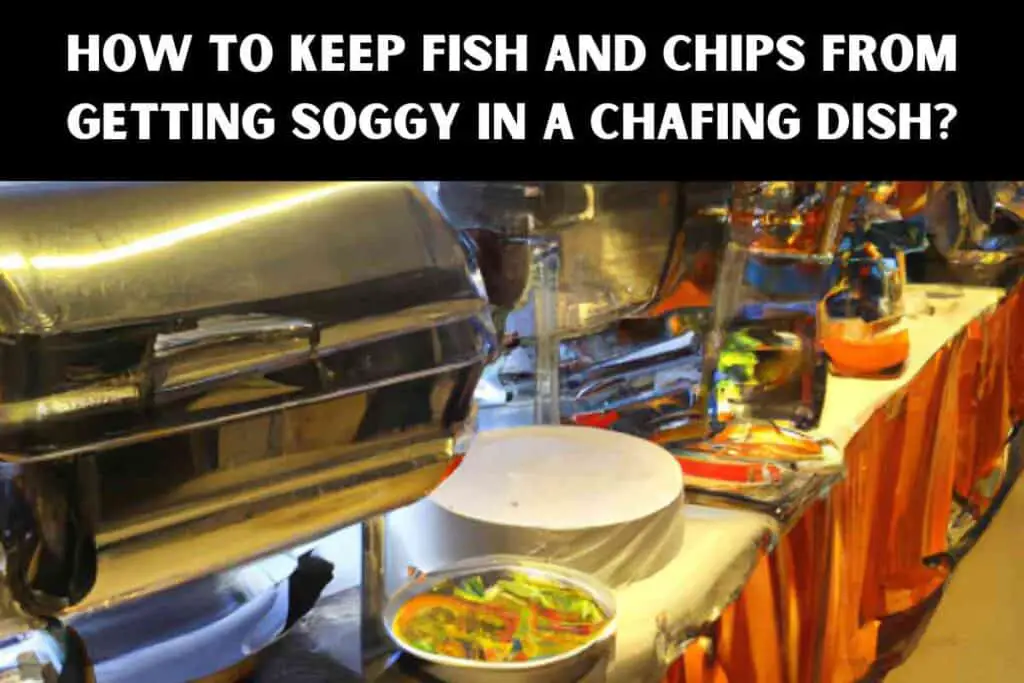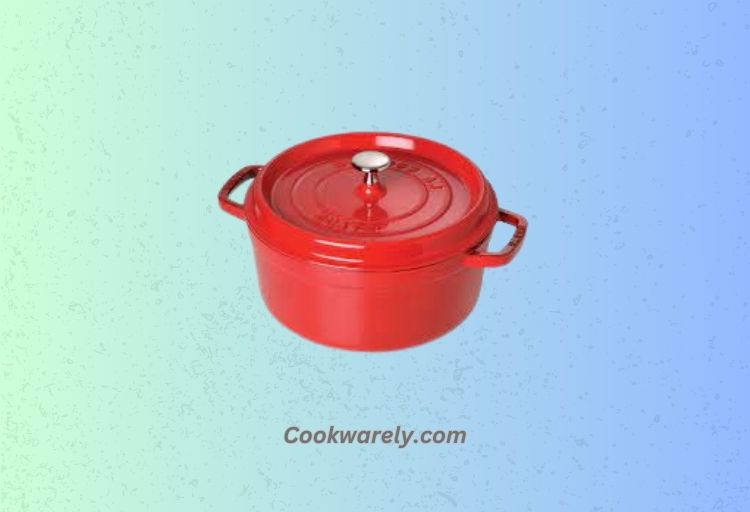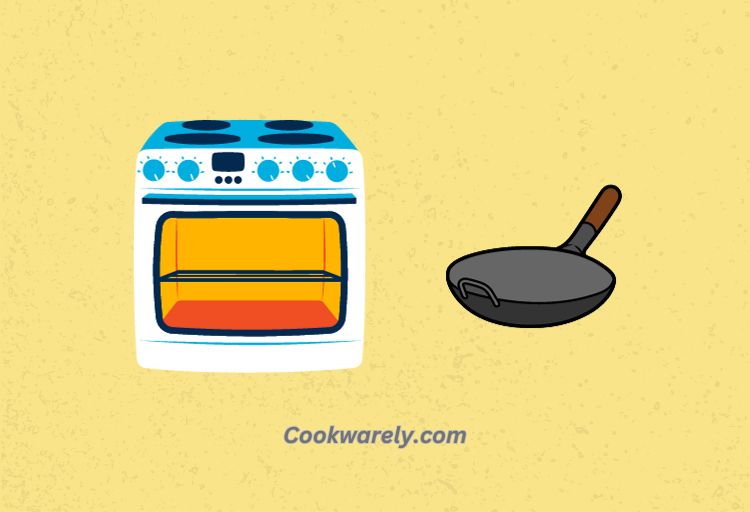5 Steps how to keep fish and chips warm
How to keep fish and chips warm? Keep the fish and chips separate in the dish so they do not touch each other. This will help to keep the fish and chips warm and will keep them from getting soggy from the fish.
When serving fish and chips in a chafing dish, ensure the fish is cooked throughout to be nice and crispy. If it is not cooked through, it will absorb moisture from the chips and become soggy.
Also, serve the chips with a dipping sauce on the side so that people can add as much or as little as they like. This will help to keep the chips from getting soggy from the sauce.
Steps To Keep Fish And Chips From Getting Soggy In A Chafing Dish
| Steps | Description |
|---|---|
| 1. Rinse the Chips | Before cooking, thoroughly rinse the potato chips in cold water. This step is crucial to remove excess starch from the chips, which can contribute to sogginess. Gently agitate the chips in the water to ensure all surfaces are rinsed, but avoid over-rinsing as it can lead to a loss of flavor and texture. |
| 2. Pat Dry | After rinsing, carefully pat the chips dry using a clean kitchen towel or paper towels. Removing excess moisture is essential to achieving crispy chips. |
| 3. Preheat the Chafing Dish | Ensure your chafing dish is preheated to the desired temperature before adding the chips. A well-heated dish helps in maintaining crispiness. |
| 4. Spread Evenly | Spread the rinsed and dried chips evenly in the chafing dish. Avoid overcrowding, as this can trap steam and lead to sogginess. |
| 5. Monitor Heat | Keep a close eye on the heat source beneath the chafing dish. Adjust the flame or temperature settings to maintain the desired level of heat. |
| 6. Serve Promptly | Once the chips are heated and crispy, serve them promptly to enjoy their best texture and flavor. Leaving chips in the chafing dish for too long can lead to sogginess. |
Key Takeaways
- Rinsing removes excess starch, preventing sogginess. Avoid over-rinsing.
- Drying chips is crucial to maintain crispiness after rinsing.
- Ensure your chafing dish is well-heated before adding chips.
- Spread chips evenly to prevent steam buildup and sogginess.

Facts About Preventing Chips from Getting Soggy in a Chafing Dish
- Potato chips contain starch, and excess starch on the surface can lead to sogginess when heated. Rinsing helps remove this starch.
- After rinsing, patting the chips dry is essential. Wet chips can’t become crispy, so thorough drying is key.
- A well-preheated chafing dish ensures that chips start cooking immediately, preserving their crispiness.
- Overcrowding the chips in the dish traps steam, causing sogginess. Spread them out evenly for even cooking.
- Once the chips are crispy, serve them promptly. Leaving them in the chafing dish too long can lead to sogginess as they cool down.
How To Keep Fish And Chips From Getting Soggy In A Chafing Dish?
Fish and chips are a classic dish that everyone loves. But there’s nothing worse than getting a soggy, mushy mess when expecting a crispy, savory treat.
If you’re planning to serve fish and chips at a party or event, you might wonder how to keep them from getting soggy in a chafing dish.
Well, don’t worry – we’ve got you covered. Following are the tips and tricks for keeping your fish and chips crispy and delicious, no matter how long they sit in a chafing dish.
Step 1: Choose the Right Type of Fish
The type of fish you choose can significantly affect how well it holds up in a chafing dish. Some types of fish are more prone to getting soggy than others, so it’s important to choose wisely.
One of the best types of fish for chafing dishes is cod. Cod is a firm, flaky fish that holds up well to heat and doesn’t get too mushy. It’s also a good choice because it has a mild, delicate flavor that pairs well with various sauces and seasonings.
Other good options include haddock, pollock, and hake. These fish are also firm and flaky and hold up well in a chafing dish.
On the other hand, you should avoid using softer, more delicate fish like tilapia or soles. These types of fish are more prone to getting soggy and falling apart, which isn’t ideal for chafing dishes.
Step 2: Cook the Fish Properly
The proper cooking technique is key to keeping your fish and chips from getting soggy. Here are a few tips to keep in mind:
- Use a deep fryer or a heavy pot with at least 3 inches of oil to fry the fish. This will help the fish cook evenly and get nice and crispy.
- Don’t overcrowd the pot or fryer. If you add too many fish pieces at once, the oil temperature will drop, and the fish will absorb more oil, leading to soggy, greasy fish and chips.
- Use a thermometer to make sure the oil is at the right temperature. The ideal temperature for frying fish is 375°F. The fish will burn and get tough if the oil is too hot. If the oil is too cool, the fish absorb too much and become soggy.
- Cook the fish for the right amount of time. The cooking time will depend on the size and thickness of the fish, but a good rule of thumb is to cook the fish for about 3-4 minutes on each side.
- Drain the fish well after cooking. Use a slotted spoon or a spider strainer to remove the fish from the oil and place it on a paper towel-lined plate to drain. This will help remove excess oil and keep the fish from getting soggy.
Step 3: Keep the Fish and Chips Warm
Once the fish and chips are cooked, it’s important to keep them warm until you’re ready to serve. Here are a few tips to help you do that:
Use a chafing dish with a water pan. A chafing dish with a water pan is ideal for keeping food warm because it provides even, gentle heat. The water pan helps regulate the chafing dish’s temperature so the food doesn’t get too hot or dry.
Keep the water pan filled with hot water. The water in the pan should be hot but not boiling.
If the water boils, it can create too much steam and cause the food to become soggy. To keep the water hot, you can use a tea kettle or a small pot to refill the pan.
Use a heat source that’s appropriate for the chafing dish. If you’re using a chafing dish with a water pan, you’ll need to use a heat source that’s compatible with the dish.
Most chafing dishes are designed to be used with fuel cells or electric heat sources, so follow the manufacturer’s instructions when setting up your chafing dish.
Step 4: Use the Right Type of Batter
The type of batter you use can also make a big difference in how well the fish and chips hold up in a chafing dish. A light, crispy batter is best because it will help the fish and chips stay crunchy and flavorful.
One good option is a tempura-style batter made with a combination of flour, cornstarch, and cold water. This type of batter creates a light, crispy coating that’s perfect for fish and chips.
Another good option is a beer batter made with flour, salt, and beer. The beer in the batter helps to create a light, crispy coating that’s perfect for fish and chips. Just be sure to use a light-colored beer to avoid overpowering the flavor of the fish.
Avoid using heavy, thick batters like breadcrumbs or panko, as they can make the fish and chips too heavy and soggy.
Step 5: Serve the Fish and Chips Hot
Finally, the most important tip for keeping fish and chips from getting soggy in a chafing dish is to serve them hot. If the food sits in the chafing dish for too long, it will start to lose its heat and become soggy.
To keep the fish and chips hot and crispy, try to serve them as soon as possible after they come out of the fryer.
If you’re serving a large group, consider setting up a buffet-style table with the chafing dish and other dishes so guests can serve themselves. This will help to keep the food hot and prevent it from getting soggy.
How do you keep fried food crispy for a party?
One of the most important things to remember when cooking fried foods is to drain the oil after frying. This way, you will avoid soggy fried foods.
In addition, soggy fish and chips absorb moisture and will become soggy if stored in a humid environment. To prevent this from happening, ensure the container has vents.
A vent should be large enough to allow moisture to escape but not too large. Also, do not put fried foods into the refrigerator until they have cooled completely. Doing this can cause condensation, which will ruin the coating on your food.
To keep fried food crispy, use paper towels, brown paper bags, or newspaper to cover the dish. However, this is not a good method for retaining a crispy texture.
Another option is to place the frying dish over a cooling rack, which you can place over a baking sheet. You can also place the cooling rack in a low oven to keep the fried foods warm.
Can you put aluminum foil in a chafing dish?
Covering the food with foil can help keep it warm and prevent it from drying. Just be sure to leave a small opening at the top of the foil to allow steam to escape; otherwise, the food may become soggy.
A chafing dish is a cooking dish that holds food at a constant temperature to prevent it from getting soggy. This temperature can range from 41 to 140 degrees Fahrenheit.
Using a chafing dish to hold food is a good idea if you host a large meal with several people. However, be sure to use an oven mitt when warming a plate. Letting a plate get too hot is dangerous, as thermal shock can break it.
Aluminum foil can also help keep food warm, although you should only use it for short periods. Generally, it will maintain the heat for about 30 minutes.
Another way to keep food from getting soggy is to stir it with a spoon every time it is cooked. This will help the food remain moist and ensure that every bite tastes great.
Leaving the food in an open area will cause it to dry out and become stale faster. When cooking in a chafing dish, always use a lid to keep the heat in the food. If your food starts to get too dry, you can add water to it.
How do you transport hot food long distances?
There are a few ways to transport hot food safely. First, it’s important to ensure the food is at the proper temperature for eating.
This means that it shouldn’t be too hot or too cold. Hot food will cool down over time, so you must pack it in insulated containers. In addition to this, it’s best to pack multiple dishes together. This way, the heat will be kept in the food for longer.
You can also use an external source of heat to help keep food warm during transportation. These sources include heat packs, hot bricks, and hot water bottles.
You can place the heated external source next to the food, which will help retain the heat. Wrapping the food in a cloth or a towel can also help keep the heat in the food.
Another way to transport hot food safely is to use a cooler. You can also cook your food in advance and then reheat it once you arrive at your destination. This is the ideal option if you plan to travel long distances.
For the best results, consider using ceramic baking dishes because they’ll hold their heat better than metal ones. Otherwise, you can use disposable foil pans.
How do you keep fish and chips from getting soggy?
If you’re looking for a simple method to prevent your fish and chips from getting soggy in chafing dishes, there are several things you can do. The first thing you should do is ensure that the fish is at a proper temperature.
If it’s too cold or hot, the fish will not cook properly and become soggy. Next, you should make sure that the chafing dish doesn’t leak any liquid or splatter while cooking.
One of the easiest ways to prevent the chips from getting soggy in a Chafing dish is to rinse them before cooking. This will help remove the excess starch, but be careful not to over-rinse them, as this can cause an adverse reaction.
Also, remember that potato chips don’t cook well if they are not completely dry before they are placed in hot oil. Leaving them too wet also causes them to soak up more oil, making it harder to keep their crunch.
Another method is to place the fish in a casserole dish with a lid. This will help keep the warm food for longer. Another trick is to use a heating pack. A heating pack will keep food warm for hours. You can make one of these out of rice or cotton socks.
How to Keep Fish and Chips Warm
To keep fish and chips warm, place them on a baking sheet in a preheated oven at a low temperature (around 200°F or 93°C) or use a warming drawer until ready to serve.
How to Use a Chafing Dish
To use a chafing dish, fill the bottom pan with water, place a sterno or gel fuel can underneath, and ignite it. Then, set the food pan on top, and adjust the flame to keep your dishes warm during serving.
Final Thoughts
In the end, I hope this post is helpful for you in understanding how to keep fish and chips from getting soggy in a chafing dish.
If you’re serving fish and chips in a chafing dish, make sure the fish is cooked all the way through so it’s nice and crispy. It will absorb moisture from the chips and get soggy if not cooked.
Whether you’re hosting a party or want to enjoy classic comfort food, these tips will help you keep your fish and chips crispy and delicious. So give them a try – your guests will thank you!
Related chafing dish articles:
- Chafing Dishes For Rent
- How To Use A Chafing Dish
- How To Store Chafing Dishes
- Can You Use A Chafing Dish Without Water
- Can You Cook Food In A Chafing Dish
- How To Keep Fish And Chips From Getting Soggy In A Chafing Dish
- Can You Put Bread In A Chafing Dish
- Do Chafing Dishes Keep Food Hot
- Can Chafing Dishes Go In The Oven
- How To Keep Food Cold In A Chafer Dish
- Where To Buy Chafing Dish
- Does Chafing Dish Fuel Expire
- Can You Reheat Food In A Chafing Dish
- How Much Water Do You Put In Chafing Dish
- How Many Servings In A Chafing Dish
- How Many Chafing Dishes Fit On An 8ft Table
- How Do Chafing Dishes Work
- What Is A Chafing Dish Used For
- How Long Can Food Stay In Chafing Dish
- What Is Chafing Dish Warmer
- Can You Keep Waffles Warm In A Chafing Dish
- What Are The Dimensions Of A Chafing Dish
- How Much Food Does An 8 Qt Chafing Dish Hold
- How Long Does Chafing Dish Fuel Last
- What Is A Disposable Chafing Dish
- What Size Foil Pan For Chafing Dish
- How Long To Heat Chafing Dishes
- How Long Do Chafing Dishes Last
- How Long Do Chafing Dishes Keep Food Warm
- How Hot Do Chafing Dishes Keep Food
- Can You Keep Pancakes Warm In A Chafing Dish
- How Many Chafing Dishes Fit On A 6ft Table
- Can You Keep Pizza Warm In A Chafing Dish
- What Is The Best Way To Clean A Chafing Dish
- How To Choose Chafing Dish Buffet Set
- Best Chafing Dish Buffet Set
- How To Choose The Electric Chafing Dish
- Best Electric Chafing Dishes
- How To Choose Disposable Chafing Dishes
- Best Disposable Chafing Dishes
- Best Chafing Dish Fuel Cans






